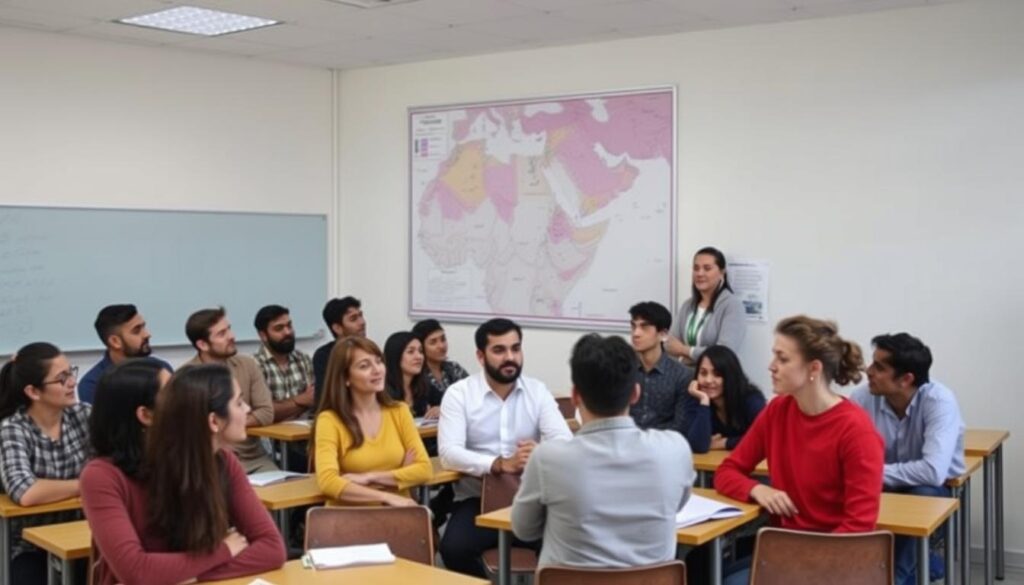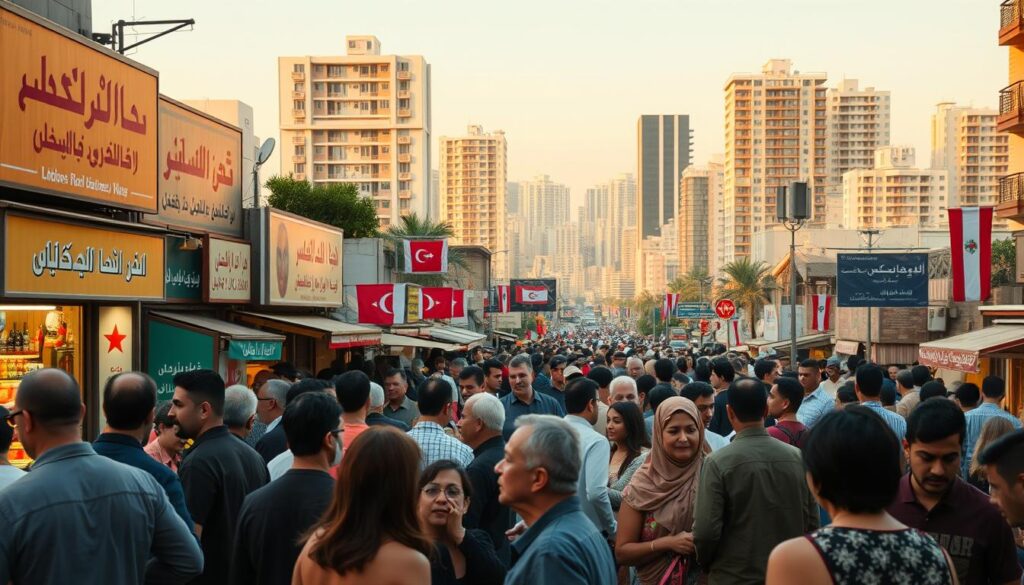As you delve into the world of Arabic dialects, you’ll find that the Lebanon dialect is a fascinating language that reflects the country’s rich heritage. With its melodic tones and rich vocabulary, it brings you closer to the heart of the Levantine region. The Lebanon dialect is a dialect of Arabic, and it is spoken in Lebanon, as well as in other parts of the Middle East, including Syria, Jordan, and Palestine, where Levantine Arabic is used across multiple countries. You can learn more about the different Arabic dialects, including the Lebanon dialect, by visiting Arabic dialects resources to explore the unique characteristics of each dialect.
The Lebanon dialect has a distinct grammar, vocabulary, and pronunciation, making it an important part of Lebanese culture and identity. As you explore the Lebanon dialect, you’ll discover its unique features, such as variations in pronunciation and word choice, which exist depending on the specific country within the Levantine region. With 78 Levantine Arabic phrases available to assist learners in starting to speak the dialect, you can begin your journey to mastering the Lebanon dialect.
Table of Contents
What Is the Lebanon Dialect?
The Lebanon dialect, a unique form of Lebanese Arabic, is a fascinating aspect of the country’s cultural heritage. As a subset of the Levantine dialect, it shares roots and grammatical structures with Modern Standard Arabic. The Middle Eastern vernacular has been shaped by various cultures and languages, including French and English, due to Lebanon’s strategic location.
The Lebanese dialect has a distinct grammar, vocabulary, and pronunciation, setting it apart from other forms of Arabic. Understanding its origin and history is essential to appreciating its significance in Lebanese culture. The Levantine dialect, spoken in multiple countries, including Syria, Jordan, and Palestine, has a rich history and has been influenced by various languages.
Some key features of the Lebanese dialect include:
* Unique pronunciation and vocabulary
* Distinct grammatical structures
* Influences from French and English
* Shared roots with Modern Standard Arabic
The Lebanese dialect is an integral part of the country’s identity, and its preservation is crucial for maintaining the country’s cultural heritage. As you explore the Lebanon dialect, you will discover its unique characteristics and the significant role it plays in Lebanese culture, reflecting the country’s history and its position in the Middle Eastern vernacular.
Key Features of the Lebanon Dialect
When exploring the Lebanese colloquial language, you’ll notice its unique blend of Dialectal Arabic and other influences. The Lebanon dialect has distinct phonological characteristics, with a blend of classical Arabic roots and borrowed words from Turkish, French, and English. This blend is reflected in the Lebanese slang and idiomatic expressions used in everyday conversation.
To better understand the Lebanon dialect, it’s essential to examine its key features. These include pronunciation differences, common vocabulary variations, and unique expressions. For instance, the integration of French words into Lebanese Arabic is evident in common phrases such as بونجور (good morning) and ميرسي (thanks). You can learn more about the Lebanon dialect and its features by visiting this guide to Lebanese Arabic.
Some notable features of the Lebanon dialect include:
- Pronunciation differences, such as the vowel shift known as Imālah
- Common vocabulary variations, including borrowed words from French and English
- Unique expressions and Lebanese slang, which add flavor to everyday conversations
By understanding these key features, you’ll be better equipped to communicate effectively with native speakers and appreciate the richness of the Lebanese colloquial language.
The Influence of Arabic in Lebanon’s Dialect
As you explore the Lebanese language, you’ll notice its strong connection to Arabic dialects. The Levant region dialects, which include Lebanese, have distinct features shaped by history, culture, and geography. Lebanese language, in particular, has been influenced by Arabic, with many similarities in grammar and vocabulary.
One of the key aspects of Lebanese dialect is its unique pronunciation, which differs from Standard Arabic. The dialect has also borrowed words from other languages, such as French and English, reflecting the country’s cosmopolitan nature. This blend of languages has created a rich linguistic tapestry, with Lebanese dialect being an integral part of the Arabic dialects spoken in the Levant region.
Some notable features of Lebanese dialect include its simple grammar and flexible sentence structures, making it easier to learn and use in everyday conversations. The dialect is also known for its expressive vocabulary, which includes classical Arabic roots and loanwords from other languages.
Understanding the influence of Arabic on the Lebanese dialect is essential to appreciating its significance and importance in Lebanese culture. By exploring the similarities and differences between Lebanese dialect and Standard Arabic, you can gain a deeper understanding of the language and its role in the Levant region.
Lebanese Dialect in Everyday Life
As you explore the Lebanese culture, you’ll notice that the Lebanese Arabic dialect plays a significant role in everyday conversations. The Lebanese colloquial language is an integral part of building relationships and establishing trust among locals. In casual conversations, you’ll often hear unique expressions and slang that are characteristic of the Middle Eastern vernacular.
In Lebanon, greetings are an essential part of social interactions. Locals use the Lebanese dialect to greet each other, and it’s not uncommon to hear phrases like “marhaba” (hello) or “keef halak” (how are you?). The Lebanese dialect is also used in formal settings, such as in education and government, although Standard Arabic is also widely used.
Understanding the Lebanese dialect is essential to appreciating its significance and importance in Lebanese culture. With over 70 Lebanese learning videos available on YouTube and more than 18,000 subscribers on the YouTube channel, it’s clear that there’s a growing interest in learning the Lebanese dialect. Whether you’re looking to learn the dialect for personal or professional reasons, there are many resources available to help you get started.
Some key features of the Lebanese dialect include its unique pronunciation, vocabulary, and grammatical structures. For example, the Lebanese dialect has a distinct pronunciation of the “q” sound, which is often pronounced as a “k” or “g” sound. Additionally, the dialect has a rich vocabulary that reflects the country’s history and cultural influences.
Casual Conversations
In casual conversations, the Lebanese dialect is used to discuss everyday topics, such as food, family, and social events. Locals often use the dialect to share stories and jokes, and it’s not uncommon to hear laughter and lively discussions in social gatherings.
How Locals Greet Each Other
In Lebanon, greetings are an important part of social etiquette. Locals use the Lebanese dialect to greet each other, and it’s customary to use formal titles such as “mr.” or “ms.” when addressing someone you don’t know well. As you learn the Lebanese dialect, you’ll become more familiar with the customs and traditions of the Lebanese culture, and you’ll be able to communicate more effectively with locals.
The Role of Lebanese Media and Entertainment
Lebanese media and entertainment play a significant role in promoting the Lebanese language and culture. The Lebanese dialect, a unique blend of Arabic dialects and Levantine dialect, is widely used in media and entertainment, including TV series, music, and film. This has helped to create a sense of national identity and pride among the Lebanese people.
The Lebanese media landscape is diverse, with many TV channels, radio stations, and newspapers catering to different tastes and preferences. Al-Nahār and Al-Safīr are two of the most popular Arabic newspapers in Lebanon, while L’Orient–Le Jour and The Daily Star are well-known French-language and English-language newspapers, respectively. The Lebanese media has a significant impact on the development of the Lebanese language, with many TV shows and radio programs using the Lebanese dialect to connect with their audience.
Some notable examples of Lebanese TV series and films that have gained international recognition include West Beirut and Where Do We Go Now?. These productions have helped to promote the Lebanese language and culture, showcasing the country’s rich heritage and diversity. The Lebanese film industry has also seen a resurgence in recent years, with many young filmmakers producing high-quality films that have gained recognition at international film festivals.
In conclusion, the Lebanese media and entertainment industry plays a vital role in promoting the Lebanese language and culture, both locally and internationally. By using the Lebanese dialect in TV series, music, and film, the industry helps to create a sense of national identity and pride among the Lebanese people, while also showcasing the country’s rich cultural heritage to the world.
| TV Series | Year | Awards |
|---|---|---|
| West Beirut | 1998 | International Film Festival |
| Where Do We Go Now? | 2011 | Cannes Film Festival |
Learning the Lebanon Dialect
As you embark on learning the Lebanon dialect, you’ll discover a rich and expressive language that is closely related to other Levantine dialects, ensuring mutual intelligibility across Syria, Jordan, and Palestine. Lebanese Arabic, also known as Lebanese colloquial language, is spoken by millions of people in Lebanon and is widely recognized and understood across the Arab world. To get started, you can explore various resources and tools available, such as language courses, textbooks, and online resources that provide comprehensive instruction and practice in the dialect.
Some popular platforms, like Playaling, offer structured learning to help users master Lebanese Arabic, focusing on practical language skills. These platforms include interactive tools and real-world videos to enhance the learning experience. Additionally, you can immerse yourself in the language by listening to Lebanese music, watching Lebanese TV programs, and practicing with native speakers. Understanding Dialectal Arabic is essential to mastering the language and communicating effectively with native speakers.
Here are some tips for beginners:
- Start with the basics: Learn the Lebanese alphabet, common phrases, and vocabulary.
- Practice regularly: Use language learning apps, watch Lebanese videos, and engage in conversations with native speakers.
- Immerse yourself in the culture: Listen to Lebanese music, try Lebanese cuisine, and attend cultural events.

By following these tips and using the available resources, you can become proficient in Lebanese Arabic and enhance your communication with locals, fostering stronger business relationships and promoting inclusivity and understanding in diverse communities.
| Resource | Description |
|---|---|
| Playaling | Structured learning platform for Lebanese Arabic |
| LanguageXS | Translation and interpretation services for Lebanese Arabic |
Challenges in Learning the Lebanon Dialect
As you delve into the world of Lebanese language, you’ll encounter several challenges that can make learning the dialect a complex task. The Lebanese language is part of the Arabic dialects spoken in the Levant region, and its unique phonetic nuances and cultural contexts can be difficult to master. For instance, the dialect has several distinct sounds and intonation patterns that can be hard to pronounce, and it also has a rich collection of idiomatic expressions and cultural references that can be difficult to understand.
One of the main challenges in learning the Lebanon dialect is its phonetic nuances. The dialect has several sounds that don’t exist in other languages, and mastering these sounds can be a significant challenge. Additionally, the dialect is heavily influenced by Arabic, and it has several grammatical and vocabulary differences that can be challenging for learners to master. The Levant region dialects, including the Lebanese language, have a unique blend of Arabic, Turkish, and French influences, which can make learning the dialect even more complex.
Some of the key challenges in learning the Lebanon dialect include:
- Mastering the distinct sounds and intonation patterns of the dialect
- Understanding the cultural contexts and references that are unique to the dialect
- Dealing with the influence of Arabic on the dialect’s grammar and vocabulary
- Navigating the blend of Arabic, Turkish, and French influences in the Levant region dialects
Despite these challenges, learning the Lebanon dialect can be a rewarding experience. With the right resources and support, you can master the dialect and gain a deeper understanding of the culture and history of the region. Whether you’re interested in learning the dialect for personal or professional reasons, it’s essential to approach the task with patience, dedication, and a willingness to learn.
The Lebanon Dialect and Diaspora Communities
The Lebanese Arabic dialect plays a significant role in maintaining cultural identity and heritage among diaspora communities. With an estimated 4 million to 14 million people of Lebanese descent living abroad, the Lebanese colloquial language is an essential part of connecting with other community members and passing down traditions to younger generations.
In countries such as Brazil, Argentina, and the United States, the Middle Eastern vernacular is widely spoken among Lebanese diaspora communities. According to estimates, the largest diaspora population is in Brazil, with between 5 million and 7 million people of Lebanese descent. The Lebanese population in the United States is estimated to be around 440,279 to 450,000.

Despite the challenges of maintaining the dialect abroad, many Lebanese diaspora communities continue to use the Lebanese colloquial language in their daily lives. This is evident in the significant number of Lebanese restaurants, cultural events, and community centers that promote the use of the Lebanese Arabic dialect.
Some notable countries with significant Lebanese diaspora populations include:
- Brazil: 5 million to 7 million
- Argentina: 1.2 million to 1.5 million
- United States: 440,279 to 450,000
- France: 300,000
- Canada: 250,000
The use of the Lebanese colloquial language in these communities helps to preserve the cultural heritage and traditions of Lebanon, even among those living abroad.
Conclusion: Embracing the Lebanon Dialect
As we conclude our exploration of the captivating Lebanon dialect, it’s clear that this unique linguistic gem is an integral part of Lebanese culture and identity. The Lebanon dialect, with its distinct features and influences from the Levant region, reflects the country’s rich heritage and diverse history. By embracing and preserving this dialect, we can celebrate the linguistic diversity that makes the so vibrant and engaging.
The found throughout the have long been a source of fascination for linguists and language enthusiasts alike. The Lebanon dialect, in particular, stands out with its melodic intonations, unique vocabulary, and subtle variations that vary across different regions. Mastering this dialect not only enhances your ability to communicate effectively with locals but also provides a deeper appreciation for the cultural nuances that shape the Lebanese way of life.
As we look to the future, it is essential that the Lebanon dialect continues to be cherished and passed down to future generations. By supporting educational initiatives, promoting the use of the dialect in media and entertainment, and fostering a greater understanding of its significance, we can ensure that this linguistic treasure remains a vital part of the Lebanese identity. Embracing the Lebanon dialect is not just about preserving language; it’s about celebrating the cultural tapestry that makes this country so remarkable.
Source Links
- 78 Levantine Arabic Phrases To Start Speaking – StoryLearning – https://storylearning.com/learn/arabic/arabic-tips/levantine-arabic-phrases
- Lebanese Arabic Classes with Teachers & Tutors Online – https://preply.com/en/online/tutors-lebanese-arabic
- Arabic Dialects Translation: Which Arabic to Translate to? – bayantech.com – https://bayan-tech.com/blog/arabic-dialects-translation/
- Dubbing Turkish drama in the Lebanese dialect – DeafCat Studios – https://deafcatstudios.com/dubbing-turkish-drama-into-lebanese/
- What Languages are Spoken in Lebanon? – MosaLingua – https://www.mosalingua.com/en/what-languages-are-spoken-in-lebanon/
- Learn Lebanese Arabic Online | Playaling – https://playaling.com/dialects/levantine-arabic/lebanese/
- Levantine Arabic for Language Learners – Lingualism.com – https://lingualism.com/levantine-arabic/levantine-arabic-for-language-learners/
- Learn Arabic In Lebanon And Beirut – KALIMAH – https://kalimah-center.com/learn-arabic-in-lebanon-and-beirut/
- Lebanese Arabic with Hiba – Your Guide to Mastering the Dialect – https://lebanese-arabic.com/
- Decoding the Arabic Language Dialects – https://www.accelingo.com/arabic-language-dialects/
- Shou, shinou, ey: Five major Arabic dialects and what makes them unique – https://www.middleeasteye.net/discover/five-major-spoken-arabic-dialects-unique
- Lebanon – Art, Music, Poetry | Britannica – https://www.britannica.com/place/Lebanon/The-arts
- Lebanon media guide – https://www.bbc.com/news/world-middle-east-14648683
- Cinema of Lebanon – https://en.wikipedia.org/wiki/Cinema_of_Lebanon
- Mastering Lebanese Arabic: Navigating The Dialect Of Lebanon – https://languagexs.com/lebanese-arabic-dialect-guide/
- Teaching at the right level: A promising educational approach for Lebanon – https://blogs.worldbank.org/en/arabvoices/teaching-at-the-right-level-a-promising-educational-approach-for-lebanon
- Exploring the Lebanese Language – ILAB Academy – https://ilab.academy/en/exploring-the-lebanese-language/
- Lebanese diaspora – https://en.wikipedia.org/wiki/Lebanese_diaspora
- Lebanese people – https://en.wikipedia.org/wiki/Lebanese_people
- Lebanon Languages – https://www.familysearch.org/en/wiki/Lebanon_Languages
- What is levantine arabic – Linguistic features and practices – https://albahertrainingcenter.com/discover-the-beauty-of-levantine-arabic-with-albaher/
- Learn Arabic In The Middle East: Best Places, Cities, And Options – KALIMAH – https://kalimah-center.com/learn-arabic-in-the-middle-east/
- Arabic Voiceover – Professionalvoiceovers.com – https://www.professionalvoiceovers.com/languages/arabic-voiceover

